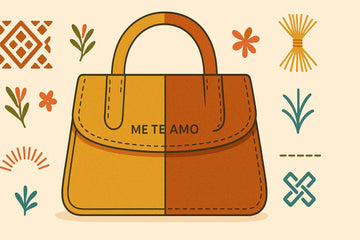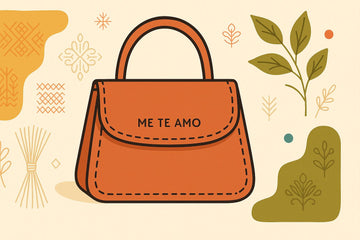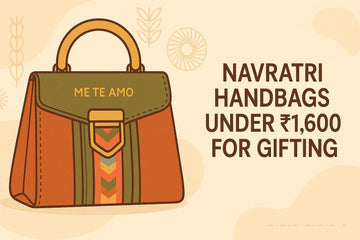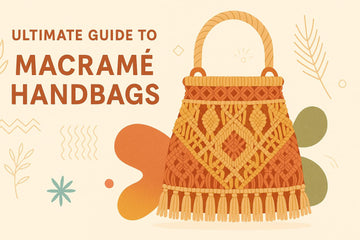
When choosing between vegan and leather handbags in India, there are two main factors to consider: cost and durability. Vegan handbags are generally more affordable upfront, starting at ₹350, but their lifespan depends on the quality of materials, lasting anywhere from 1 to 20 years. Leather handbags, while pricier (₹200–₹3,800), can last decades with proper care, developing a unique appearance over time.
Key Points to Decide:
- Cost: Vegan bags are cheaper to produce and buy, while leather is an investment for long-term use.
- Durability: Leather lasts longer and ages well; vegan options vary by type (PU, PVC, plant-based).
- Maintenance: Vegan bags are low-maintenance, while leather requires regular care.
- Ethics: Vegan bags avoid animal products, but synthetic versions may have environmental drawbacks.
- Climate Suitability: Humidity and heat affect both materials differently, with leather needing careful storage and vegan materials varying in resilience.
Quick Comparison
| Aspect | Vegan Handbags | Leather Handbags |
|---|---|---|
| Price Range | ₹350–₹4,900 | ₹200–₹3,800 |
| Lifespan | 1–20 years (depends on material) | 20–40 years (with care) |
| Maintenance | Easy, occasional cleaning | Requires regular conditioning |
| Ethical Concerns | Cruelty-free | Involves animal products |
| Climate Suitability | Varies; some soften in humidity | Needs careful storage to avoid mould |
Your choice depends on your budget, style preferences, ethical values, and how much effort you're willing to put into maintenance. Vegan bags are ideal for affordability and eco-consciousness, while leather offers unmatched longevity and classic appeal.
Vegan Leather: Better Than Animal Leather?
Cost Comparison: Vegan Handbags vs Leather Bags
Understanding the costs of vegan and leather handbags involves looking at both upfront prices and long-term value. Over time, the price difference between these two materials has reduced, making vegan options an appealing choice for budget-conscious shoppers.
Price Ranges of Vegan and Leather Bags
In India, handbags cater to a wide range of budgets, with both vegan and leather options available across different price points. Leather handbags are commonly found in price brackets ranging from ₹200 to ₹3,800. Popular choices often fall between ₹300 and ₹700. Online platforms make it easy to browse options with filters like "Under ₹500", "₹500 - ₹1,000", "₹1,000 - ₹2,500", "₹2,500 - ₹5,000", and "Over ₹5,000".
Vegan leather handbags, on the other hand, tend to have a slightly higher price range but offer good value. Market data shows these bags are priced between ₹350 and ₹4,900, with premium models sometimes exceeding this range. Affordable options are also available, starting at around ₹350.
Brands like ME TE AMO bridge the gap between affordability and luxury by offering vegan handbags priced between ₹699 and ₹2,499. Their use of permanent discounts makes these bags accessible while maintaining a premium feel, particularly appealing to women in Tier-1 and Tier-2 cities.
| Price Range | Leather Handbags | Vegan Leather Handbags |
|---|---|---|
| Budget (Under ₹500) | ₹200–₹500 | ₹350–₹500 |
| Mid-Range (₹500–₹2,000) | ₹500–₹1,560 | ₹699–₹1,874 |
| Premium (₹2,000+) | ₹2,000–₹3,800 | ₹2,499–₹4,900 |
These price differences are often tied to the underlying production costs of each material.
Production Costs and Affordability
When it comes to production, vegan leather has a cost advantage. Synthetic vegan leather is generally cheaper to produce compared to traditional leather, which involves costly processes like hide procurement, tanning, dyeing, and finishing. These steps require specialised equipment, skilled labour, and chemicals, driving up the price of leather products.
In contrast, producing vegan leather - especially synthetic varieties - allows manufacturers to streamline processes, minimise waste, and scale production more efficiently. This predictability in production costs helps brands offer competitive pricing, which resonates with Indian shoppers who often prioritise affordability. For instance, ME TE AMO combines skilled craftsmanship with sustainable practices to deliver quality handbags at accessible prices.
However, while production costs impact the initial price, the overall value also depends on how long the bag lasts and how often it needs replacing.
Long-Term Costs and Replacement Frequency
The true cost of a handbag goes beyond the initial price tag. Durability and replacement frequency play a big role in determining long-term value. Leather handbags are known for their longevity, but lower-priced leather options may wear out faster, requiring more frequent replacements. Similarly, the lifespan of vegan leather bags depends on the quality of materials and construction. While some may need replacing sooner, high-quality vegan leather options can last longer.
Maintenance is another factor to consider. Leather requires regular conditioning and careful handling to maintain its appearance, whereas vegan leather is much easier to care for, often needing just a quick wipe-down. By weighing upfront costs against durability and maintenance, buyers can make a more cost-effective decision.
Durability and Longevity: Vegan vs Leather
When deciding between vegan and leather handbags, understanding how long each material lasts and how well it performs under different conditions can help you make an informed choice. Both materials now offer commendable durability, but they differ in how they age, handle various climates, and require maintenance. Here’s a closer look at their lifespan, performance in Indian conditions, and upkeep requirements.
Expected Lifespan of Vegan and Leather Bags
Traditional leather, when cared for properly, can last an impressive 20–40 years or more. Over time, it develops a natural patina, adding character to the bag.
Vegan leather, on the other hand, varies in lifespan depending on its type and quality. High-quality faux leather can last 10–20 years with proper care. However, the durability of specific types of vegan leather differs significantly:
- PU leather bags: Typically last 2–5 years.
- PVC leather options: Shorter lifespan of about 1–2 years.
- Plant-based leather alternatives: Generally last 3–6 years.
The quality of the material plays a crucial role. For instance, high-grade PU leather, when maintained well, can rival traditional leather in durability. Brands like ME TE AMO use premium vegan leather trims to ensure their products stand the test of time.
Performance in Indian Climates
India’s diverse climate - ranging from sweltering summers to humid monsoons - can significantly affect how these materials hold up.
Humidity poses a particular challenge. Vegan leather, especially lower-quality options, tends to soften and lose structure faster in humid conditions. Traditional leather, while sturdier, is not immune to issues like mould growth if not stored properly. Regular airing and using paper stuffing can help prevent such problems.
Heat and sunlight also impact both materials. Prolonged exposure to high temperatures or direct sunlight can cause lower-grade vegan leather to crack or peel. Traditional leather fares better under heat but can fade or dry out if not conditioned regularly.
During the monsoon, water resistance becomes critical. PVC vegan leather offers better water resistance compared to PU, while plant-based leathers often have natural water-repellent properties. Traditional leather, although somewhat moisture-resistant, benefits greatly from conditioning to maintain its protective barrier during heavy rains.
To extend the life of your bag, regardless of the material, it’s essential to take care of it. Use protective sprays, store bags in cool, dry places, and clean them regularly with a soft cloth and mild soap.
Pros and Cons of Each Material
Both vegan and traditional leather come with their own set of strengths and challenges when it comes to durability and maintenance.
Vegan leather is easier to maintain, requiring only occasional cleaning with a damp cloth and mild soap. This makes it a practical choice for those with busy schedules.
Traditional leather, on the other hand, is celebrated for its unmatched longevity and its ability to age beautifully over time.
| Aspect | Vegan Leather | Traditional Leather |
|---|---|---|
| Care | Low – simple cleaning with a damp cloth | High – needs regular conditioning |
| Moisture Resistance | Varies by type (PVC > PU > Plant-based) | Moderate (improves with conditioning) |
| Heat Tolerance | Prone to cracking in extreme heat | Better resilience to heat |
| Humidity Performance | Softens faster in humid conditions | Requires careful storage to avoid mould |
| Ageing | Shows wear faster | Develops a beautiful patina over time |
| Repair Options | Limited repair options | Can often be professionally restored |
Ultimately, your choice between vegan and traditional leather depends on what matters most to you. If you value convenience and ethical considerations, high-quality vegan leather offers dependable durability with minimal effort. However, if you prioritise maximum longevity and don’t mind putting in the time for upkeep, traditional leather remains a classic option.
For Indian consumers, it’s important to weigh local climate factors alongside personal preferences to pick a handbag that will serve you well for years.
sbb-itb-be0b177
Ethics and Environmental Impact
In India, buying decisions are increasingly influenced by ethical and environmental considerations. With a growing awareness of sustainability and animal welfare, many consumers are weighing the broader effects of choosing vegan versus leather bags. Understanding these impacts can guide more responsible choices.
Environmental Impact of Vegan vs Leather Bags
The environmental footprint of handbags largely depends on the materials and production processes involved. Traditional leather, for instance, requires significant amounts of water, land, and energy due to the demands of livestock farming and tanning. Livestock farming is a major source of methane emissions, while the tanning process often involves harmful chemicals that can contaminate water supplies.
On the other hand, synthetic vegan leathers, typically made from PU (polyurethane) or PVC (polyvinyl chloride), use less water and land but rely on chemical processes that can release toxins. PVC-based vegan leathers, in particular, may emit dioxins during production, which pose health risks for workers and harm the environment. Both options have their drawbacks - traditional leather impacts the environment through resource-heavy farming and tanning, while synthetic vegan leathers contribute to fossil fuel dependence and potential toxin emissions.
When it comes to carbon footprints, traditional leather tends to have a higher impact due to the energy-intensive nature of livestock farming and tanning. Synthetic vegan leathers, while lower in direct carbon emissions, are made from fossil fuel derivatives and can lead to microplastic pollution.
Durability is another factor to consider. Synthetic vegan leathers often have shorter lifespans, leading to more frequent replacements and increased waste. In contrast, plant-based vegan leathers - crafted from materials like pineapple leaves, apple peels, cork, and mushrooms - offer biodegradable solutions. However, these environmentally friendly alternatives are still limited in availability and often come with higher price tags, making them less accessible for many Indian consumers. These considerations highlight the importance of looking beyond materials to assess ethical production practices.
Supporting Ethical and Eco-Friendly Choices
Ethical production practices are just as important as environmental factors when evaluating a handbag’s impact. This means looking at the entire production chain, from sourcing materials to labour conditions. Vegan handbags inherently avoid animal exploitation, aligning with values of cruelty-free living and animal welfare.
Indian brand ME TE AMO is a standout example of ethical and sustainable practices in action. The brand uses cruelty-free materials like jacquard cotton blends, hand-loom cotton, vegan leather trims, and recycled polyester linings. By avoiding animal harm and embracing eco-friendly materials, they uphold values that resonate with socially conscious consumers.
ME TE AMO also takes steps to reduce its environmental impact by employing paper-based shipping methods and low-waste cutting techniques, which help minimise packaging waste and production inefficiencies. The brand’s dedication to ethical labour practices is evident in its support for women artisans. Each handbag is handcrafted in its own workshop, preserving traditional Indian textile techniques while providing fair wages and opportunities for women.
For Indian consumers, choosing brands like ME TE AMO means aligning their purchases with their values - supporting cruelty-free, eco-conscious products while promoting ethical labour practices. This shift toward responsible buying is particularly evident among young, urban women, who are driving demand for sustainable and ethical fashion.
Conclusion: Choosing the Right Handbag for You
Picking the perfect handbag isn't just about looks - it's about finding what fits your priorities, lifestyle, and values. Both vegan and leather options come with their own set of perks and compromises, making them suitable for different needs and preferences.
Cost vs Durability: What to Keep in Mind
When it comes to costs, initial price tags only tell part of the story. Vegan bags are often more affordable upfront and offer decent durability, lasting around 3–5 years with regular use. On the other hand, full-grain leather bags, though more expensive initially, can last for decades if cared for properly. Over time, they develop a rich patina, adding character and uniqueness to the bag. This makes leather a better value for those looking for longevity and durability.
Factors like climate, how often you use the bag, and your willingness to maintain it also play a big role. These elements underline the trade-off between cost and durability.
Finding the Right Fit for Your Lifestyle
Here’s how you can make a choice that works best for your lifestyle and needs:
- If you like to switch up your style often, vegan bags are a great option. They’re affordable, allowing you to explore different trends, colours, and designs without overspending. Plus, their 3–5 year lifespan means you can refresh your collection regularly without breaking the bank.
- For those who view handbags as long-term investments, high-quality leather bags are worth considering. Full-grain leather not only lasts for decades but also offers timeless appeal. However, they do require proper care and maintenance to retain their quality.
- Think about your daily routine and environment. If your bags see heavy use - whether it’s frequent travel, daily commutes, or business meetings - leather might be the sturdier, long-lasting choice. Vegan bags, while stylish and ethical, may not hold up as well under intense daily wear.
Balance is key. Vegan bags deliver ethical options and flexibility, especially for those who prioritise affordability and style experimentation. On the flip side, leather bags are ideal for those seeking durability and classic elegance, provided they’re ready to invest time in maintenance. Brands like ME TE AMO cater to urban Indian consumers by offering stylish, ethically made, and budget-friendly options.
At the end of the day, the best handbag is one that aligns with your financial situation, style preferences, ethical values, and practical needs. Whether you lean towards the ethical appeal and affordability of vegan handbags or the timeless durability of leather, make sure your choice reflects what truly matters to you.
FAQs
What are the environmental benefits of choosing vegan handbags over leather ones?
Vegan handbags often have a smaller environmental footprint compared to traditional leather bags. By steering clear of animal products, they not only help reduce animal cruelty but also sidestep the resource-heavy processes tied to animal farming and leather tanning. These processes are notorious for consuming vast amounts of water and using harmful chemicals.
That said, not all vegan materials are the same. Some vegan leathers, particularly those derived from plastics like polyurethane, can contribute to microplastic pollution and involve production methods laden with chemicals. In contrast, plant-based vegan leathers - crafted from materials like cork, pineapple fibres, or recycled products - tend to be kinder to the planet.
When selecting a vegan handbag, it's wise to opt for brands that emphasise sustainable materials and ethical practices. This way, you can make a choice that's genuinely better for the environment.
What are the key differences in maintaining vegan handbags versus leather handbags, and how can I ensure their long-term durability?
Vegan handbags are often simpler to care for compared to leather ones. Cleaning them is straightforward - just use a damp cloth with a bit of mild soap. Steer clear of harsh chemicals or abrasive cleaners, as these can cause cracking or peeling. To keep them looking their best, give them a quick wipe-down regularly and store them in a cool, dry spot.
Leather handbags, however, demand a bit more attention. They benefit from periodic conditioning with products made specifically for leather to maintain their softness and prevent drying or cracking. It's also crucial to shield leather bags from too much moisture, heat, or direct sunlight, as these can harm the material.
Regardless of whether your bag is vegan or leather, avoid overloading it and exposing it to extreme conditions. While vegan bags are generally more resistant to environmental wear, proper care will help both types stay durable and stylish for years to come.
How does the durability of vegan leather compare to traditional leather in India’s climate?
In India’s varied climate, traditional leather often holds up better than vegan leather when it comes to durability. Genuine leather is naturally more resistant to humidity, heat, and temperature changes, making it a reliable choice for long-term use. With the right care, it can last for decades, even in tough conditions.
On the other hand, vegan leather, particularly synthetic options like PU, has its limitations. It’s more likely to crack or peel over time, especially when exposed to water or high humidity. While premium vegan leather can last several years with proper care, it’s generally more susceptible to damage in India’s climate. To extend the life of vegan leather products, it’s best to keep them away from direct sunlight, moisture, and extreme temperatures.
If you’re looking for a cruelty-free yet stylish alternative, ME TE AMO offers a selection of handcrafted vegan handbags. Made with high-quality materials, these bags strike a balance between durability and affordability. With a little care, your vegan leather bags can stay in excellent condition for years.




